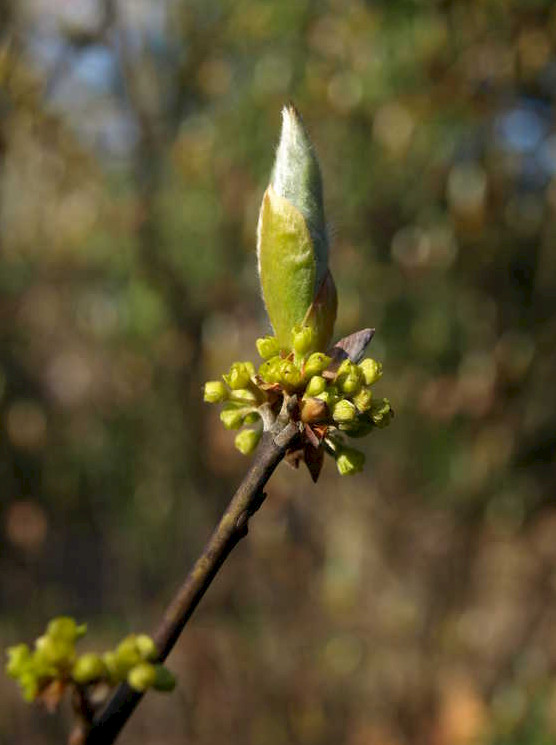Lindera reflexa
Sponsor
Kindly sponsored by
a member of the International Dendrology Society
Credits
Julian Sutton (2023)
Recommended citation
Sutton, J. (2023), 'Lindera reflexa' from the website Trees and Shrubs Online (treesandshrubsonline.
Genus
Other taxa in genus
- Lindera aggregata
- Lindera akoensis
- Lindera angustifolia
- Lindera assamica
- Lindera benzoin
- Lindera chienii
- Lindera communis
- Lindera erythrocarpa
- Lindera floribunda
- Lindera fragrans
- Lindera glauca
- Lindera megaphylla
- Lindera melissifolia
- Lindera metcalfiana
- Lindera neesiana
- Lindera obtusiloba
- Lindera praecox
- Lindera pulcherrima
- Lindera rubronervia
- Lindera sericea
- Lindera tonkinensis
- Lindera triloba
- Lindera umbellata
Deciduous shrub or small tree to 4 m. Bark brown, with longitudinal fissures. Young branchlets yellow-green, silky-hairy at first, lacking lenticels. Winter buds horn-shaped, red. Leaves pinnately veined with 6–8(–10) pairs of lateral veins; blade membranous, elliptic to obovate or ovate, (5–)9–12(–16.5) × (2.5–)5.5–8(–12.5) cm; upper surface dark green, with hairs only on the midrib; lower surface white hairy at first; base rounded, broadly cuneate or slightly cordate; margin entire; apex acuminate; petiole 0.6–3 cm, pubescent at first. Umbels on each side of leaf bud, on hairy peduncles 3 mm long, each umbel with 4 involucral bracts and 5 flowers. Flowers with 6 yellowish tepals; male flowers with fertile stamens all the same length; female flowers with reduced, fasciated staminodes and a disc-shaped stigma. Fruit globose, red at maturity, ~0.7 cm. Flowering April, fruiting August (China). (Cui & van der Werff 2008; Grimshaw & Bayton 2009).
Distribution China Anhui, Fujian, Guangdong, Guangxi, Guizhou, Henan, Hubei, Hunan, Jiangsu, Jiangxi, Yunnan, Zhejiang
Habitat Valleys, forests and thickets on mountain slopes; below 1000 m.
USDA Hardiness Zone 6-7
RHS Hardiness Rating H5
Conservation status Least concern (LC)
Although well established in cultivation, Lindera reflexa does little to stand out among the shrubby, deciduous species in gardens. Usually a medium-sized shrub (The Tree Register (2023) records specimens 1.5–3 m tall in English gardens), the yellow flowers emerge just before or with the leaves. There is little evidence of the red fruit being produced in gardens, probably because both male and female plants would need to be present. Autumn colour can be a feature. Bunting (2021) describes his own plant offering ‘a beautiful suffusion of orange and yellow in the fall’, but this is not always the case (see images below).
Lindera reflexa is distinguished from the other species we list with deciduous, pinnately veined leaves by a set of characters. The branchlets have quite distinctive yellow-green bark, smooth and largely without lenticels, while the red-scaled winter buds are rather large and horn-shaped. The umbels are on distinct peduncles, longer than 3 mm but shorter than the pedicels of each flower (Cui & van der Werff 2008). The slightly aromatic leaves are comparitively large and broad (‘almost magnolia-like’ – Grimshaw & Bayton 2009) but variable in shape even on a single shoot, especially perhaps in young cultivated plants (Allen 1941). The type specimen was, unhelpfully, just such a plant grown at Hong Kong Botanic Garden, originally collected near Guangzhou (Forbes & Hemsley 1891). Hemsley’s specific epithet apparently refers to the perianth segments, which he described as ‘arcte reflexa’ (tightly reflexed), a feature not mentioned in later descriptions nor apparent in images of wild plants (Chinese Academy of Sciences 2023). A widespread species of southern and eastern China, L. reflexa was traditionally used to treat gastrointestinal problems; possible uses in modern medicine are being investigated (Fu et al. 2022).
It was introduced to western gardens from China by Camellia Forest Nursery, NC, probably in the 1980s (Raulston 1993). Garden stocks probably all trace back to this. It is present in serious North American collections on both Atlantic and Pacific seaboards (US National Arboretum 2023; JC Raulston Arboretum 2023; University of British Columbia 2023), and in several Belgian collections (Plantcol 2023), as well as being offered occasionally by British nurseries.







